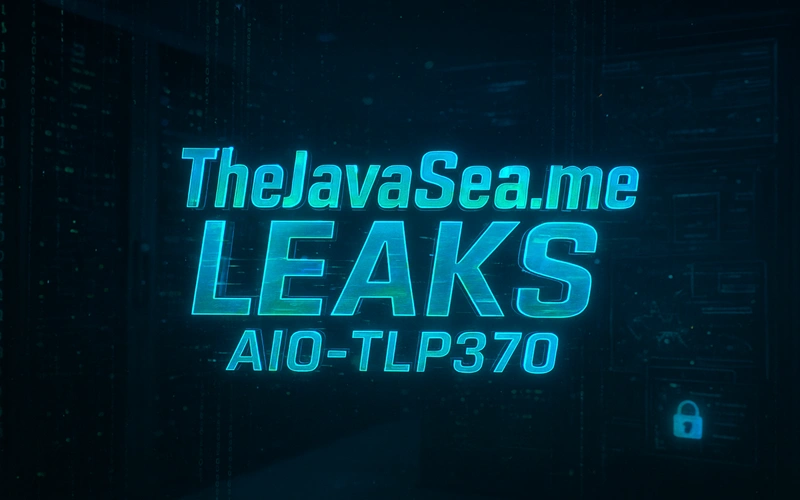Imagine you have a super-secret diary where you write all your important thoughts, and someone sneaks it onto the internet for everyone to see. That’s kind of what happened with the TheJavaSea.me leaks AIO-TLP370 in 2025. This wasn’t just any leak—it was a massive spill of private digital information that got the whole cybersecurity world buzzing. But what exactly is this leak, why is it such a big deal, and what can we do about it? Let’s break it down in a way that’s easy to understand, like explaining a game to a friend.
The TheJavaSea.me leaks AIO-TLP370 refers to a huge bundle of sensitive data—think of it like a digital treasure chest—that was shared on a website called TheJavaSea.me. This chest, named “aio-tlpfullv7.3.zip,” was 1.2 gigabytes of private information, including computer codes, secret keys, and instructions that companies use to keep their systems safe. When this information got out, it was like giving a map to a bank vault to anyone who wanted it. Let’s dive into what this leak contains, why it matters, and how it affects businesses, developers, and even regular people like you and me.
What Is AIO-TLP370?
To understand the TheJavaSea.me leaks AIO-TLP370, we first need to know what AIO-TLP370 is. AIO stands for “All-In-One,” and TLP means “Traffic Light Protocol,” which is a fancy way of saying that some information is meant to be shared carefully, like a secret you only tell your best friend. The “370” part is like a version number, showing this is a specific update of the tool.
AIO-TLP370 is a powerful tool used by companies to keep an eye on their computer systems. Think of it like a super-smart librarian who organizes all the books (data) in a library (company’s network) and alerts the staff if something looks wrong, like a missing book or a suspicious visitor. It collects logs—records of what’s happening in the system—analyzes them, and sends alerts if there’s trouble. It can even hide private details to follow rules like those protecting your personal information.
This tool is used by DevOps teams (people who manage tech systems), security experts, and businesses that need to keep their digital stuff safe. But when the TheJavaSea.me leaks AIO-TLP370 happened, all the secret instructions and keys that make this tool work were exposed, like someone leaving the library’s master key on a park bench.
Read More: 5starsstocks.com Best Stocks
What Was Exposed in the TheJavaSea.me Leaks AIO-TLP370?
On March 22, 2025, a file called “aio-tlpfullv7.3.zip” appeared on a paste site, shared by anonymous people linked to TheJavaSea.me. This file was a goldmine for hackers because it contained:
-
Source Code: The “recipe” for how AIO-TLP370 works, including special algorithms and connectors that let it talk to other systems. It’s like sharing the blueprints for a high-tech security system.
-
Configuration Files: These are like instruction manuals with secret codes (API keys and tokens) that let the tool access important systems, such as cloud services or databases.
-
Developer Notes: Plans for future updates, like adding smarter detection using machine learning or making it work better with modern systems. It’s like leaking a company’s secret project plans.
-
Incident Response Playbooks: Guides on what to do if something goes wrong, like how to handle a cyberattack. This is like giving burglars the schedule of when the security guards take breaks.
-
Sensitive Logs: Records of what the tool was monitoring, which could show patterns of how a company’s systems work.
This mix of information is dangerous because it gives hackers a clear map to break into systems that use AIO-TLP370 or similar tools. The TheJavaSea.me leaks AIO-TLP370 didn’t just expose one company’s secrets—it potentially put thousands of businesses at risk.
Why Is the TheJavaSea.me Leaks AIO-TLP370 Such a Big Deal?
You might be wondering, “Why does this matter to me?” Well, the TheJavaSea.me leaks AIO-TLP370 is a big deal for a few reasons, and it’s not just about tech experts. Here’s why it’s like a storm in the digital world:
-
Hackers Get a Head Start: With the source code and secret keys, bad actors (hackers) can figure out how to sneak into systems. It’s like giving them the keys to a locked door and a map of the house.
-
Ripple Effect: Many companies share similar tools or codes. If one gets exposed, it can affect their partners, clients, or even customers like you, whose data might be stored in those systems.
-
Trust Issues: When leaks like this happen, people lose trust in companies. Imagine if your favorite game company got hacked—you might worry about your account details getting stolen.
-
Money and Reputation Loss: Companies hit by this leak could lose money fixing the problem or face angry customers. It’s like a store having to close because someone broke in and messed everything up.
-
National Security Risks: If government systems use tools like AIO-TLP370, this leak could make them vulnerable, which could affect things like public safety.
The TheJavaSea.me leaks AIO-TLP370 showed how one weak link in the tech world can cause a chain reaction, affecting businesses, developers, and even regular internet users.
Who Is at Risk?
The TheJavaSea.me leaks AIO-TLP370 puts a lot of people and groups in danger. Here’s who needs to watch out:
-
Businesses Using AIO-TLP370: Companies that rely on this tool for monitoring their systems are at high risk. Hackers could use the leaked information to break in.
-
Developers and DevOps Teams: People who build or manage tech systems might have used parts of AIO-TLP370’s code without knowing it was exposed.
-
Customers: If a company’s system gets hacked, your personal info—like your name, email, or even credit card details—could be stolen.
-
Software Vendors: Companies that make similar tools might find their systems targeted if they share code or methods with AIO-TLP370.
-
Governments: If government agencies use this tool, the leak could weaken their defenses, which is a big problem for everyone.
Even if you’re not directly using AIO-TLP370, you could still be affected if a company you trust gets hit. It’s like how one kid getting sick at school can spread germs to everyone else.
How Did the TheJavaSea.me Leaks AIO-TLP370 Happen?
Nobody knows exactly how the leak started, but experts have some guesses. It could have been:
-
A Disgruntled Insider: Someone who worked on AIO-TLP370 might have shared the files out of anger or for money. It’s like a chef leaking a restaurant’s secret recipe.
-
A Supply Chain Attack: Hackers might have broken into a partner company’s system to steal the data, like sneaking through a back door to get to the main vault.
-
A Security Mistake: A weak password or an unpatched system could have let hackers in. It’s like forgetting to lock your bike and finding it gone.
TheJavaSea.me is a shadowy website that often hosts leaked files, and it’s not clear who runs it. They claim to “unveil hidden tech,” but their actions can cause a lot of harm. The leak spread fast, showing up on sites like GitHub and Discord, making it hard to contain.
What Can Businesses Do to Stay Safe?
If a company thinks they might be affected by the TheJavaSea.me leaks AIO-TLP370, they need to act fast. Here’s a step-by-step plan, explained simply:
-
Check Everything: Look through their systems for any signs of the leaked codes or keys. It’s like checking your house for open windows after hearing about a break-in nearby.
-
Change All Keys: Replace any secret codes (like API keys) that might have been exposed. Think of it as changing the locks on your doors.
-
Update Systems: Install the latest security patches to fix any weak spots. It’s like fixing a hole in a fence.
-
Watch Closely: Keep an eye on system logs for weird activity, like someone trying to log in from an unknown place.
-
Train Everyone: Teach employees not to use risky codes or share sensitive info. It’s like teaching your friends not to give out your secret clubhouse password.
Long-term, companies should use secure storage for secrets (like a digital safe), check their code regularly, and make sure they only use trusted tools. This helps prevent future leaks.
What Can You Do to Protect Yourself?
Even as a regular person, you can take steps to stay safe after something like the TheJavaSea.me leaks AIO-TLP370:
-
Use Strong Passwords: Make your passwords long and unique, like a secret code only you know. A password manager can help you keep track.
-
Turn On Two-Factor Authentication (2FA): This is like adding an extra lock to your accounts, requiring a second step (like a code sent to your phone) to log in.
-
Check Your Accounts: Look at your bank or online accounts for anything strange, like purchases you didn’t make.
-
Be Careful Online: Don’t click on sketchy links or download files from unknown sites. It’s like not opening a suspicious package.
-
Stay Informed: Keep up with news about data breaches so you know if a company you use was affected.
By doing these things, you can protect your personal info, even if a big leak happens.
The Bigger Picture: Why Leaks Like This Keep Happening
The TheJavaSea.me leaks AIO-TLP370 isn’t a one-time thing. Leaks happen because our digital world is super connected, and one mistake can ripple out. Companies often rely on shared tools or code, which is great for working together but risky if something gets exposed. It’s like everyone in a neighborhood sharing the same gate key—if it gets stolen, everyone’s in trouble.
This leak also shows why we need better cybersecurity habits, like:
-
Encrypting Data: Locking up sensitive info so only the right people can see it.
-
Regular Checks: Looking for weak spots in systems before hackers do.
-
Smarter Sharing: Only sharing secret info with people who really need it, using rules like the Traffic Light Protocol.
By learning from this leak, companies and people can build stronger defenses, like adding more locks to a treasure chest.
Looking Ahead: The Future of Cybersecurity
The TheJavaSea.me leaks AIO-TLP370 is a wake-up call for everyone. It shows that cybersecurity isn’t just a tech problem—it’s about trust, safety, and protecting our digital lives. Moving forward, we’ll likely see:
-
Cool New Tech: Things like artificial intelligence and blockchain could make systems safer by spotting problems faster or locking data more securely.
-
Stricter Rules: Governments might make tougher laws to punish companies that don’t protect data well.
-
More Training: Companies will teach their workers how to avoid mistakes that lead to leaks.
By taking these steps, we can make the internet a safer place, like building a stronger fence around our digital neighborhood.
Conclusion
The TheJavaSea.me leaks AIO-TLP370 is a big deal because it exposed secret tools that keep our digital world safe. It’s like someone spilling the plans for a city’s security system, putting businesses, developers, and everyday people at risk. By understanding what happened, who’s affected, and how to stay safe, we can all play a part in protecting our information. Whether you’re a company fixing your systems or a kid making sure your game account is secure, every step counts. Let’s learn from this leak and make our digital world stronger together.
FAQs About the TheJavaSea.me Leaks AIO-TLP370
1. What is the TheJavaSea.me leaks AIO-TLP370?
It’s a 2025 data breach where a 1.2 GB file containing secret codes, keys, and plans for a tool called AIO-TLP370 was shared on TheJavaSea.me, putting many systems at risk.
2. How can I protect myself from this leak?
Use strong, unique passwords, turn on two-factor authentication, check your accounts for weird activity, and avoid suspicious links or downloads.
3. Why is this leak dangerous for companies?
It gives hackers the tools to break into systems, steal data, or cause damage, which can cost companies money and trust from their customers.
Read More: Science Facts for Kids


